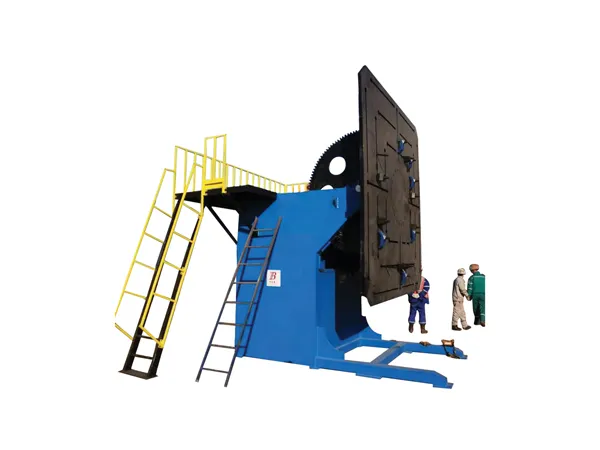Welding positioner torque requirements are crucial for selecting the right equipment to safely and efficiently manipulate a workpiece during welding. Understanding these requirements ensures the positioner can handle the weight and dimensions of your weldment without damage or instability.

In the context of welding positioners, torque refers to the rotational or twisting force that the positioner's motors and gearing must exert to move and hold the workpiece in various orientations. There are typically two main types of torque to consider:
Rotational Torque: The force required to rotate the workpiece around its axis (e.g., spinning a pipe).
Tilting Torque: The force required to tilt the workpiece from horizontal to vertical or any angle in between.
The torque requirements for a welding positioner are primarily determined by the characteristics of the workpiece and how it's mounted. Here are the main factors:
Weight of the Workpiece (and Fixture): This is the most significant factor. The heavier the workpiece, the more force (and thus torque) is needed to move and hold it. Don't forget to include the weight of any chucks, clamps, or custom fixtures used to hold the workpiece.
Center of Gravity (CG): This is the point where the entire weight of an object appears to act. Its location is critical:
Distance from the table's rotational center (Eccentricity): For rotational torque, the further the CG is from the center of rotation, the greater the rotational torque required. This is especially important for irregularly shaped parts or those with significant offset loads (like pipe elbows or Tees).
Distance from the table's tilting pivot point (Gravity Center Distance + Inherent Overhang): For tilting torque, the further the CG is from the tilt axis, the more tilting torque is needed. "Inherent overhang" is the fixed distance from the tilting pivot point of the table to its surface.
Workpiece Shape and Dimensions: Large, unwieldy, or asymmetrical workpieces can create larger moments (force x distance) and thus higher torque demands, even if their absolute weight isn't extreme.
Desired Positioning Speed: While not directly a torque requirement, faster rotation or tilting speeds generally require more powerful motors, which are often associated with higher torque capabilities.
Welding Process and Material: While less direct, certain welding processes might require very precise and stable positioning, indirectly influencing the need for a robust positioner with sufficient torque to prevent any unwanted movement.
Dynamic Loads: During welding, adding material or even the act of welding itself can subtly shift the center of gravity, and a positioner should be able to handle these minor dynamic changes without instability.

To determine the appropriate positioner, you need to calculate both the rotational and tilting torque for your heaviest and most eccentric workpiece.
The general formulas are:
Rotational Torque:
T rotational =Weight of workpiece (W)×Eccentricity distance (Y)
W: Total weight of the workpiece (and fixture)
Y: Distance from the center of the table plate to the workpiece's center of gravity (measured parallel to the table surface). This is also sometimes called the "offset distance" of the CG from the rotational axis.
Tilting Torque:
T tilting=Weight of workpiece (W)×(Gravity Center Distance (X)+Inherent Overhang)
W: Total weight of the workpiece (and fixture)
X: Distance from the tilting axle to the workpiece's center of gravity (measured perpendicular to the table surface).
Inherent Overhang: This is a specification provided by the positioner manufacturer, representing the fixed distance from the tilting pivot point of the table to the surface of the table.
Units:
Ensure consistent units (e.g., pounds and inches for torque in lb-in, or kilograms and meters for torque in N-m).
Safety: An under-sized positioner can become unstable, leading to the workpiece tipping, falling, or experiencing uncontrolled movement, posing significant safety hazards to operators.
Weld Quality: Adequate torque ensures smooth and consistent rotation and tilting, allowing for optimal "downhand" welding positions. This leads to higher quality welds, reduced defects, and less rework.
Productivity: A properly sized positioner minimizes setup time and allows welders to work efficiently in comfortable positions, leading to increased output.
Equipment Longevity: Overloading a positioner by exceeding its torque capacity can cause premature wear and tear on motors, gearboxes, and other components, leading to costly repairs and downtime.
Automation: For automated welding systems, precise control enabled by a correctly sized positioner is essential for repeatable and accurate welds.

Once you've calculated your required rotational and tilting torques, compare these values to the specifications provided by positioner manufacturers. These specifications typically list the maximum allowable rotational and tilting torque for each model, often presented in tables or charts that factor in the center of gravity distance.
It's always recommended to select a positioner with a capacity equal to or greater than your calculated requirements, building in a safety margin for unforeseen variations in workpiece characteristics or future needs. If you have particularly complex or asymmetrical workpieces, it's advisable to consult with the positioner manufacturer for expert guidance on selection.
No. 1 Intersection of Chuangye Avenue and Weilai Avenue,
Yiyang County,Luoyang City, Henan Province, China
+86 400-0379-069
Copyright © 2023 An Automated Welding and Cutting Equipment Manufacturer Focusing on Welding Column Boom and Welding Rotator | All Rights Reserved Technical support: ShangXian